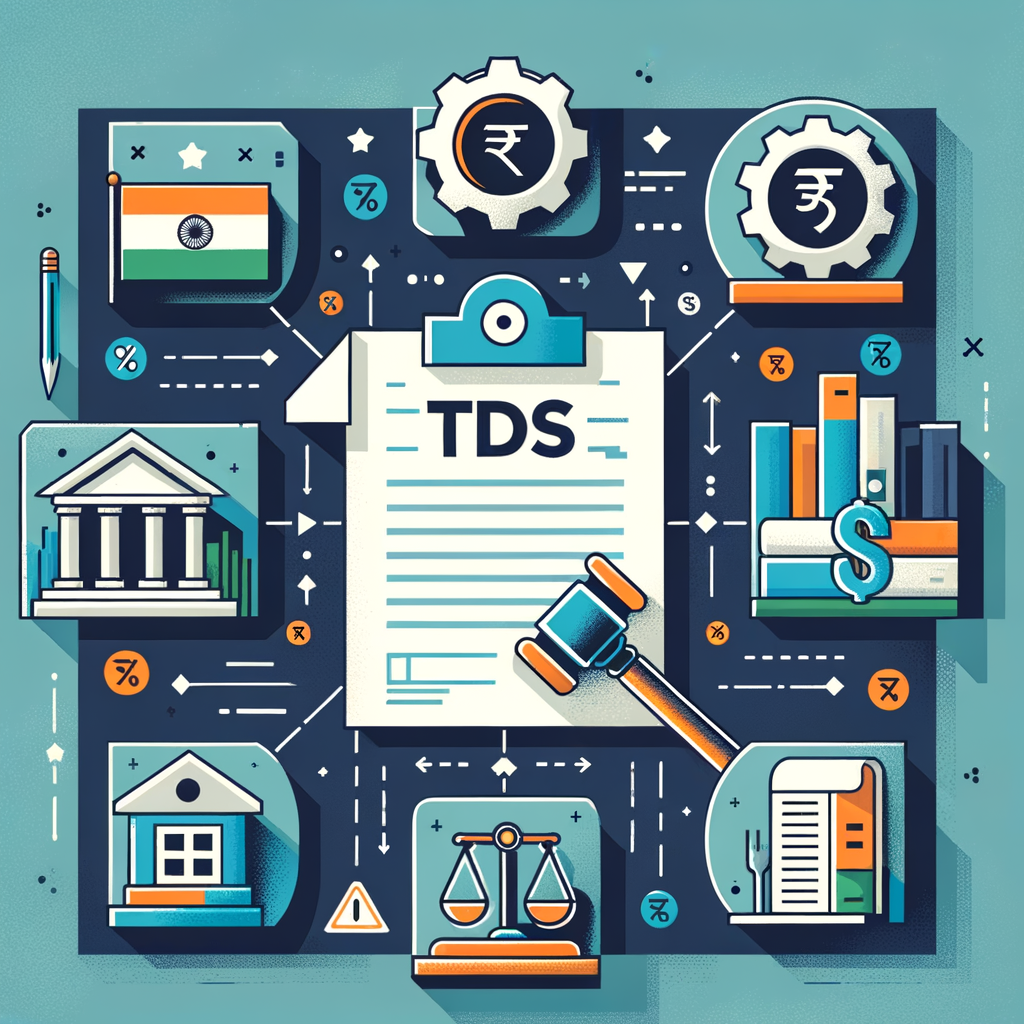TDS on Rent, Contractors & Commission – Latest Rules and Penalties
Are you a business paying a freelancer, a professional paying office rent, or a salaried individual renting a home for over ₹50,000 a month? If so, understanding Tax Deducted at Source (TDS) is crucial for you. TDS is an essential mechanism used by the Indian government to collect income tax directly from the source of income generation. This system ensures a steady revenue flow for the government and helps prevent tax evasion. This guide will simplify the often-complex rules surrounding TDS on rent, payments to contractors, and commission payouts. Navigating these regulations is not just about following the law; it’s about safeguarding your financial health, as non-compliance can lead to significant penalties. Whether you are a business owner or a salaried employee, mastering the specifics of TDS on contractor payments and TDS on commission is a non-negotiable part of financial management in India.
A Comprehensive Guide to TDS on Rent in India (Section 194-I & 194-IB)
The rules governing TDS on rent in India are primarily covered under two distinct sections of the Income Tax Act: Section 194-I and Section 194-IB. These sections cater to different types of payers, and understanding which one applies to you is the first step towards ensuring TDS compliance for property rental in India. For businesses, Section 194-I is usually the relevant provision, while Section 194-IB was introduced to bring high-value rental transactions by salaried individuals and professionals under the tax net. Each section has its own set of rules regarding who needs to deduct, when to deduct, and how to deposit the tax with the government. While TDS is about tax deduction, understanding How to Calculate Tax on Rental Income can give landlords a complete picture of their tax obligations.
Who is Liable to Deduct TDS on Rent?
The responsibility to deduct TDS on rental payments depends on the status of the person or entity making the payment. The law clearly segregates these responsibilities to ensure broad coverage.
- Section 194-I: This section applies to any person (other than an individual or a Hindu Undivided Family – HUF) who is paying rent. However, it also includes individuals and HUFs if their total sales, gross receipts, or turnover from business or profession exceeded the prescribed limits (₹1 crore for business or ₹50 lakh for profession) during the financial year immediately preceding the current financial year. In simple terms, this section is primarily aimed at businesses and professionals who are subject to a tax audit.
- Section 194-IB: This provision was specifically introduced to cover individuals and HUFs who are not required to get their accounts audited. If you are a salaried individual or a small business owner below the audit threshold and you pay a monthly rent of more than ₹50,000, you are liable to deduct TDS under this section. This rule ensures that high-rental income earned by landlords from individuals is also brought into the tax ambit.
Understanding the Threshold Limits and TDS Rates for Rent
The obligation to deduct TDS on rent only arises when the rental payments exceed certain specified limits within a financial year. These thresholds and the applicable tax rates vary between Section 194-I and 194-IB. It is crucial to be aware of these figures to avoid any compliance misses. Remember that if the landlord does not provide their Permanent Account Number (PAN), the TDS rate jumps to a steep 20%.
- Threshold for Section 194-I: TDS must be deducted if the total amount of rent paid or credited during the financial year is likely to exceed ₹2,40,000.
- Threshold for Section 194-IB: TDS is applicable if the rent paid per month or part of a month exceeds ₹50,000.
Here is a clear breakdown of the current TDS rates for rent:
| Type of Payment | TDS Rate (If PAN is available) | TDS Rate (If PAN is not available) |
|---|---|---|
| Rent for Plant & Machinery (Sec 194-I) | 2% | 20% |
| Rent for Land/Building/Furniture (Sec 194-I) | 10% | 20% |
| Rent under Sec 194-IB | 5% | 20% |
How to Deposit TDS and File Returns for Rent
The procedure for depositing the deducted tax and filing the corresponding returns differs for businesses and individuals.
- For Section 194-I: Businesses and audited professionals must deposit the TDS on a monthly basis using Challan ITNS-281. The due date for payment is the 7th of the following month (e.g., TDS for June must be deposited by July 7th). After depositing the tax, a quarterly TDS return must be filed in Form 26Q.
- For Section 194-IB: The process for individuals is much simpler. You are required to use Form 26QC, which is a challan-cum-statement for reporting and paying the TDS. This payment is typically made only once a year, within 30 days from the end of the financial year or within 30 days from the last day of tenancy if you vacate the property mid-year. You can make this payment online through the TIN-NSDL e-payment portal.
- TDS Certificate: After depositing the tax, the deductor must issue a TDS certificate to the landlord. Under Section 194-I, Form 16A is issued quarterly. Under Section 194-IB, Form 16C must be issued to the landlord within 15 days of filing Form 26QC.
Decoding the Latest TDS Rules for Contractors (Section 194C)
Section 194C of the Income Tax Act governs the deduction of tax at source on payments made to contractors. This is one of the most frequently used TDS provisions for businesses of all sizes, from startups to large corporations. The term ‘contractor’ is defined very broadly, covering a wide range of services. Understanding the latest TDS rules for contractors is vital for any business that outsources work, as it directly impacts cash flow and compliance for both the business and the service provider.
Who is a ‘Contractor’ under Income Tax Law?
The term ‘work’ under Section 194C is not limited to traditional construction or labor contracts. It has a wide and inclusive definition that covers many common business-to-business transactions. If your business makes a payment for any of the following services, the rules for TDS on contractor payments in India will likely apply.
- Advertising: Payments made to advertising agencies.
- Broadcasting and telecasting: This includes the production of programs for such broadcasting or telecasting.
- Carriage of goods and passengers: Payments to transporters, by any mode of transport other than railways.
- Catering: Providing food and beverage services for events, canteens, etc.
- Manufacturing or supplying a product according to a customer’s specification: This is often referred to as contract manufacturing, where a business supplies raw materials to a contractor who then manufactures a product as per the given requirements.
Thresholds and TDS Rates for Contractor Payments
TDS under Section 194C is not applicable to every small payment. The law provides specific monetary thresholds to ease the compliance burden for minor transactions. TDS needs to be deducted only if:
- A single payment made to a contractor exceeds ₹30,000, OR
- The aggregate of all payments made to the same contractor during a financial year exceeds ₹1,00,000.
Once these limits are crossed, TDS must be deducted at the applicable rate on the entire amount.
| Payment made to | TDS Rate |
|---|---|
| Individual or HUF Contractor | 1% |
| Other Contractors (e.g., a company, firm) | 2% |
Note: If the contractor fails to furnish their PAN, you are legally obligated to deduct TDS at a much higher rate of 20%.
Differentiating Contractors (194C) from Professionals (194J)
A common point of confusion for businesses is whether to deduct TDS under Section 194C (for contractors) or Section 194J (for professional or technical services). This distinction is critical because the TDS rates are significantly different (1%/2% for 194C vs. 10% for 194J). The key difference lies in the nature of the service. Section 194C applies to ‘work contracts’ that may involve labour and materials, often resulting in a tangible output. In contrast, Section 194J applies to services that are intellectual or technical in nature, such as legal advice, consultancy, accounting, or software development. These are crucial TDS updates for freelancers in India to be aware of, as their classification determines the tax deducted from their invoices. Proper understanding of TDS guidelines for service providers in India helps in accurate tax compliance and financial planning, a process detailed in our guide on Filing Tax Returns for Freelancers and Consultants.
Understanding TDS on Commissions in India (Section 194H)
Section 194H of the Income Tax Act mandates the deduction of tax on payments made in the nature of commission or brokerage. This provision is relevant for businesses that engage agents, brokers, or intermediaries to facilitate sales, procure business, or carry out other transactions on their behalf. Properly understanding TDS on commissions in India is crucial for companies in sectors like real estate, financial services, and direct selling, where commission-based payments are a standard practice.
When Does TDS on Commission or Brokerage Apply?
As per Section 194H, ‘commission’ or ‘brokerage’ includes any payment received or receivable, directly or indirectly, by a person acting on behalf of another person. This covers services rendered in the course of buying or selling of goods or in relation to any transaction involving any asset, valuable article, or thing, except securities. It is important to note that this section specifically excludes insurance commission (which is covered under Section 194D) and payments that are classified as salary to employees. Practical examples where TDS on commission in India applies include:
- Brokerage paid to a real estate agent for a property deal.
- Commission paid to a sales agent for achieving sales targets.
- Fees paid to a travel agent.
Threshold Limit and Rate for TDS on Commission
The requirement to deduct TDS under Section 194H is triggered only when the total commission or brokerage paid or likely to be paid to a single person in a financial year exceeds a certain limit.
- Threshold: The annual threshold for TDS on commission is ₹15,000. If the total payments in a financial year are expected to be below this amount, no TDS is required.
- TDS Rate: The applicable TDS rate is 5%.
- No PAN: If the agent or broker does not provide their PAN, TDS must be deducted at the rate of 20%.
The Cost of Non-Compliance: Penalties for TDS Defaults
Ignoring TDS regulations can lead to severe financial consequences. The Income Tax Department has a stringent framework of interest, fees, and penalties for various types of TDS defaults. These penalties are designed to ensure timely deduction, deposit, and filing, making compliance a critical aspect of financial management. Whether it’s a landlord facing delayed payments or a business owner overlooking filing deadlines, understanding these repercussions, including specific TDS penalties for landlords in India indirectly through their tenants’ non-compliance, is essential.
Interest on Late Deduction and Late Deposit
Interest is levied for any delay in deducting or depositing the TDS amount with the government. These interest charges are mandatory and cannot be waived.
- Interest for Late Deduction: If you fail to deduct TDS on the due date, you are liable to pay interest at 1% per month or part of the month. This interest is calculated from the date on which tax was deductible to the date on which tax is actually deducted.
- Interest for Late Deposit: If you have deducted the TDS but failed to deposit it with the government by the due date, you must pay interest at 1.5% per month or part of the month. This is calculated from the date of deduction to the date of actual payment.
Fees and Penalties for Late Filing of TDS Returns
Apart from interest, there are separate penalties for delays or errors in filing the mandatory TDS returns (like Form 26Q or 26QC).
- Late Filing Fee (Section 234E): A late filing fee of ₹200 per day is levied for every day the TDS return is delayed. This penalty continues to accrue until the fee amount equals the total TDS amount that was supposed to be reported in the return.
- Penalty (Section 271H): In addition to the late fee, the Assessing Officer has the power to impose a penalty under Section 271H: Penalties for Failure in TDS/TCS Statement Filing. This penalty can range from a minimum of ₹10,000 to a maximum of ₹1,00,000. This can be levied for non-filing of the TDS return within one year from the due date or for filing an incorrect return.
Conclusion
Mastering the rules of Tax Deducted at Source is no longer optional for businesses and individuals in India. A clear understanding of the specific provisions for TDS on rent (Sections 194-I & 194-IB), contractors (Section 194C), and commission (Section 194H) is fundamental to sound financial practice. The key lies in correctly identifying the applicable section, knowing the threshold limits, applying the correct rate, and adhering to the timelines for deposit and filing. Proactive TDS compliance is not merely a legal obligation; it is a hallmark of a financially disciplined and responsible business or individual. Timely deduction, deposit, and filing are non-negotiable pillars of this system, and overlooking them can result in a cascade of interest and penalties that can strain your finances.
Feeling overwhelmed by TDS compliance? TaxRobo’s team of experts can manage all your TDS filing and advisory needs, ensuring you remain penalty-free. Contact us today to simplify your tax obligations!
Frequently Asked Questions (FAQs)
Q1. I am a salaried individual paying ₹55,000 per month as rent. Do I need a TAN to deduct TDS?
Answer: No, for deducting TDS under Section 194-IB, you do not need to obtain a Tax Deduction and Collection Account Number (TAN). This is a special provision to simplify compliance for individuals. You can deposit the tax using your own PAN through Form 26QC on the government’s tax payment portal.
Q2. My company hired a freelance graphic designer for a project and paid them ₹40,000. Which TDS section applies?
Answer: This payment would likely fall under Section 194J (Fees for Professional Services) rather than 194C (Contractors). Graphic design is considered a professional service involving specialized skill and creativity. The TDS rate under Section 194J is typically 10%, which is different from the 1% or 2% rate under Section 194C.
Q3. What is the consequence if my landlord or contractor refuses to provide their PAN?
Answer: If the deductee (the person receiving the payment, such as your landlord or contractor) does not provide their PAN, you are legally required to deduct TDS at a higher “rate in force” or 20%, whichever is higher. As per Section 206AA of the Income Tax Act, this usually means deducting tax at 20%. This rule is in place to discourage transactions without a valid PAN.
Q4. Can a landlord claim a tax refund if my TDS deduction on rent results in excess tax paid?
Answer: Yes, absolutely. The TDS you deduct and deposit on behalf of your landlord is reflected in their Form 26AS, which is an annual consolidated tax statement. When the landlord files their income tax return, they can claim full credit for this TDS amount against their total tax liability. If their final tax liability is less than the TDS that was deducted throughout the year, they will be eligible to receive a tax refund from the Income Tax Department.



